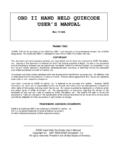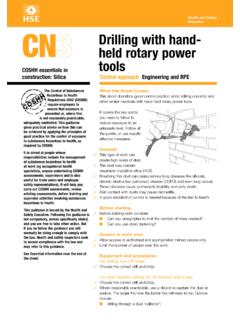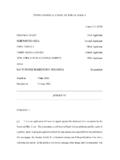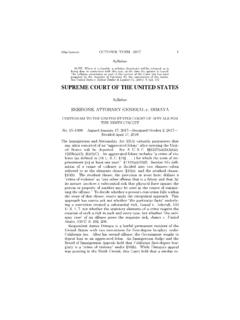Transcription of NUMBER OF JOBS, LABOR MARKET EXPERIENCE, …
1 For release 10:00 (EDT) Thursday, August 24, 2017 USDL-17-1158 Technical information: (202) 691-7410 Media contact: (202) 691-5902 NUMBER OF JOBS, LABOR MARKET EXPERIENCE, AND EARNINGS GROWTH AMONG AMERICANS AT 50: RESULTS FROM A LONGITUDINAL SURVEY Individuals born in the latter years of the baby boom (1957-1964) held an average of jobs from age 18 to age 50, the Bureau of LABOR Statistics reported today. Nearly half of these jobs were held from ages 18 to 24. These findings are from the National Longitudinal Survey of Youth 1979, a survey of 9,964 men and women who were ages 14 to 22 when first interviewed in 1979 and ages 49 to 58 when interviewed most recently in 2014-15. These respondents were born in the years 1957 to 1964, the latter years of the baby boom that occurred in the United States from 1946 to 1964.
2 The survey spans 35 years and provides information on work and nonwork experiences, education, training, income and assets, health, and other characteristics. The information provided by respondents, who were interviewed annually from 1979 to 1994 and biennially since 1994, can be considered representative of all men and women born in the late 1950s and early 1960s and living in the United States when the survey began in 1979. This release of the latest data from the longitudinal survey focuses on the NUMBER of jobs held , job duration, LABOR force participation, and earnings growth. Highlights from the survey include: Individuals born from 1957 to 1964 held an average of jobs from ages 18 to 50. These baby boomers held an average of jobs while ages 18 to 24. The average fell to jobs from ages 25 to 34, to jobs from ages 35 to 44, and to jobs from ages 45 to 50.
3 Jobs that span more than one age group were counted once in each age group, so the overall average NUMBER of jobs held from age 18 to age 50 is less than the sum of the NUMBER of jobs across the individual age groups. (See table 1.) Although job duration tended to be longer the older a worker was when starting the job, these baby boomers continued to have large numbers of short-duration jobs. Among jobs started by 35 to 44 year olds, 36 percent ended in less than a year, and 75 percent ended in fewer than 5 years. (See table 2.) On average, individuals were employed 78 percent of the weeks from age 18 to age 50. Generally, men spent a larger percent of weeks employed than did women (84 percent versus 71 percent). Women spent much more time out of the LABOR force (25 percent of weeks) than did men (11 percent of weeks).
4 (See table 3.) -2- The average annual percent growth in inflation-adjusted hourly earnings was highest during a worker s late teens and early twenties. Earnings growth rates were generally higher for college graduates than for workers with less education. (See table 5.) NUMBER of Jobs held Individuals held an average of jobs from ages 18 to 50, with nearly half of these jobs held before age 25. A job is defined as an uninterrupted period of work with a particular employer. (See the Technical Note for additional information on the definition of a job.) On average, men held jobs and women held jobs from age 18 to age 50. Men held jobs from age 18 to age 24, compared with jobs from age 45 to age 50. The reduction in the average NUMBER of jobs held in successive age groups was similar for women.
5 (See table 1.) Chart 1 shows the cumulative NUMBER of jobs held from age 18 to age 50, by sex and age. The decline in the slope of these curves indicates a decrease in the rate at which workers change jobs as they age. On average, men without a high school diploma held jobs from ages 18 to 50, while men with a bachelor s degree and higher held jobs between these ages. In contrast, women without a high school diploma held jobs from ages 18 to 50, while women with a bachelor s degree and higher held jobs between these ages. From age 18 to age 24, Whites held more jobs than Blacks, or Hispanics or Latinos. On average, Whites held jobs between the ages of 18 and 24, while Blacks held jobs, and Hispanics or Latinos held jobs. Whites, Blacks, and Hispanics or Latinos held between and jobs from age 25 to age 34, 0246810121418232833384348 NUMBER of Jobs HeldAgeChart 1: Cumulative NUMBER of jobs held from age 18 to age 50, by sex and ageMenWomen-3- and between and jobs from age 35 to age 44.
6 From age 45 to age 50, Whites, Blacks, and Hispanics or Latinos all held an average of jobs. Duration of Employment Relationships The length of time a worker remains with an employer increased with the age at which the worker began the job. Of the jobs that workers began when they were 18 to 24 years of age, 69 percent of those jobs ended in less than a year and 93 percent ended in fewer than 5 years. Among jobs started by 35 to 44 year olds, 36 percent ended in less than a year, and 75 percent ended in fewer than 5 years. (See table 2.) Percent of Weeks Employed, Unemployed, and Not in the LABOR Force On average, the youngest baby boomers (born 1957-1964) were employed during 78 percent of all the weeks from age 18 to age 50. They were unemployed that is, without jobs but seeking work 5 percent of the weeks.
7 They were not in the LABOR force that is, neither working nor seeking work 18 percent of the weeks. (See table 3.) The amount of time spent employed differed substantially between those without a high school diploma and those who had graduated from high school or attained higher levels of education. Individuals with less than a high school diploma (as of the 2014-15 survey) spent 58 percent of weeks employed and 34 percent of weeks out of the LABOR force from age 18 to age 50. By comparison, high school graduates spent 77 percent of weeks employed and 18 percent of weeks out of the LABOR force, while those with a bachelor s degree and higher spent 84 percent of weeks employed and 14 percent of weeks out of the LABOR force. White high school graduates with no college were employed a higher percentage of weeks and out of the LABOR force a smaller percentage of weeks than similarly educated Blacks, or Hispanics or Latinos.
8 0102030405060708090 Less than a high schooldiplomaHigh school graduates, nocollegeSome college or associatedegreeBachelor's degree andhigherPercent of weeks Chart 2: Percent of weeks employed from age 18 to age 50, by educational attainment, race, and Hispanic or Latino ethnicityWhite non-HispanicBlack non-HispanicHispanic or Latino-4- Among those with a bachelor s degree and higher, there was little difference among racial and ethnic groups in LABOR MARKET attachment; each group spent between 83 percent and 85 percent of weeks employed. (See chart 2.) The amount of time spent in the LABOR force differs by sex, with women at every educational level spending fewer weeks in the LABOR force than men. Overall, men were out of the LABOR force 11 percent of weeks from age 18 to age 50 and women were out of the LABOR force 25 percent of weeks.
9 Women s LABOR force participation increased with their education level. Women without a high school diploma spent more than half (52 percent) of all weeks between age 18 and age 50 out of the LABOR force, while those with a high school diploma were out of the LABOR force 26 percent of weeks, those with some college were out of the LABOR force 23 percent of weeks, and women with a bachelor s degree and higher were out of the LABOR force only 18 percent of weeks. Among men, those without a high school diploma were out of the LABOR force about 21 percent of weeks, while men in the top three education categories were out of the LABOR force only 9 percent to 11 percent of weeks. (See table 3.) The LABOR force participation patterns of men and women differed. For both groups, time spent out of the LABOR force was greatest between the ages of 18 and 24, reflecting the transition from education and training to the work force.
10 For women, time spent out of the LABOR force decreased in each successive age range, from 30 percent of weeks between the ages of 18 and 24 to 22 percent between the ages of 45 and 50. In comparison, men were out of the LABOR force fewer than 9 percent of weeks from age 25 to age 44; from age 45 to age 50, they increased their time out of the LABOR force to 12 percent of weeks. While the percent of weeks out of the LABOR force trended in different directions for the two sexes after age 24, women in each age range still spent more weeks out of the LABOR force than their male counterparts. (See table 4 and chart 3.) The percentage of weeks in which women were employed increased from 63 percent in the 18 to 24 age group to a peak of 76 percent in the 35 to 44 age group and then decreased slightly to 75 percent in the 05101520253035 Age 18 to 24 Age 25 to 34 Age 35 to 44 Age 45 to 50 Percent of Weeks Chart 3: Percent of weeks not in the LABOR force from age 18 to age 50, by sex and ageMenWomen-5- 45 to 50 age group.


















